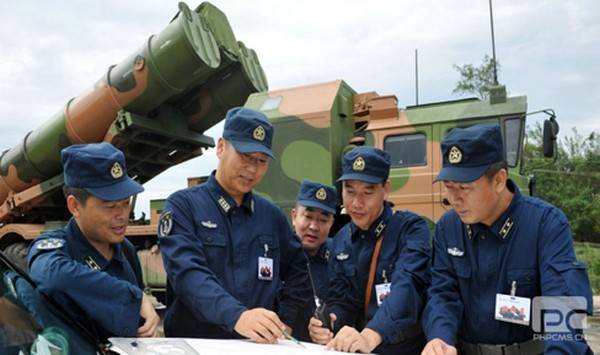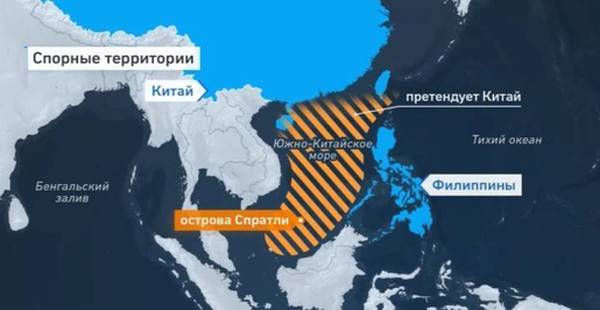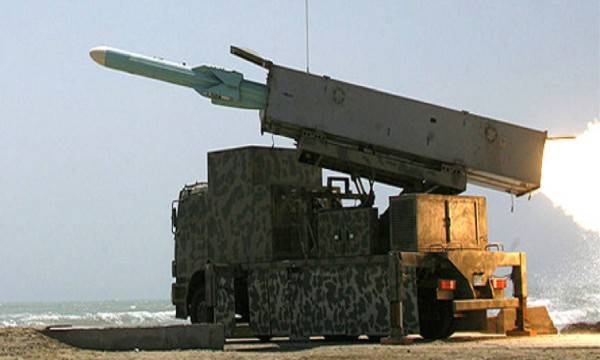Chinese defense near sea zone
Principles of application of the Chinese Navy
Coastal Defense Forces (NLA) of the naval forces of the People's Liberation Army of China (PLA) are a kind of force designed to destroy surface ships, landing troops and convoys of the enemy, cover naval bases, coastal targets fleet, coastal maritime communications and groupings of troops operating in coastal directions.

The official military doctrinal document of the People's Republic of China “The White Book on National Defense” from 26 of May 2015 of the year defines the basic principles for the use of the Chinese Navy. It emphasizes that “as part of measures to promote national interests in the current military-political situation in the world, it is necessary to pay close attention to the modernization of the national naval forces”. This provision is clarified in the Chinese Policy on Security Cooperation in the Asia-Pacific Region published in January 2017, which reveals the views of the PRC leadership on the country's military activities in the region, including the defense of coastal waters. In addition, Xi Jinping, Chairman of the PRC and Secretary General of the Communist Party of China, said at the 12 naval parade on April 2019 that “the task of developing powerful national naval forces has never been as urgent as today, we will steadily accelerate their modernization and strive to reach the world level ".
Chinese military experts note that at the present stage, the main task of the Navy PLA is to build a near defensive line that is built along the coast. In China, it is called the "first island chain", which includes the coastal waters of the South China, East China and Yellow Seas. UBO Navy PLA has a key role to play in ensuring security in the area, including because of existing territorial disputes in the region. In turn, the distant frontier of defense extends into the open ocean at a distance of up to 1500 nautical miles from the coast, and the main goal of the PLA Navy in this zone is to counteract foreign warships carrying cruise missiles, as well as aircraft carriers on which the strike deck is based aviation.

Thus, the Chinese Navy is faced with the task of protecting the coast of the People's Republic of China, along which most of the population lives in favorable climatic conditions and is located around 70% of industrial enterprises. According to Chinese military experts, to achieve the long-term political goals of the country in the region, the role of the national naval forces, including their land component, is expected to increase further.
Organizational structure of the PLA Navy
At present, the PLA Navy Command, taking into account its own experience and developments of leading foreign countries in the field of application of coastal defense forces, has developed the optimal, in its opinion, organizational and staff structure of this kind of force. The basis of UBO is rocket and artillery troops. In addition, this type of force structurally includes means of radar detection, electronic warfare (EW), electronic countermeasures (REB), air defense (AD) and anti-airborne forces.
Territorially, the UBO is divided into areas that are operatively subordinate to the command of the respective fleet: the Northern Fleet - six areas of the Bo: Dalian, Yingkou, Qinhuangdao, Tianjin, Weihai and Jiaonan; Eastern Fleet - six districts of BO: Lianyungang, Usun, Dinghai, Wenzhou, Ningde, and Xiamen; The Southern Fleet - six areas of the BO: Zhanjiang, Beihai, Huangpu, Shantou, Haikou, and Xisha (Paracel Islands).
The combat structure of the UBE Navy PLA includes 35 missile and artillery regiments, 20 separate missile battalions armed with anti-ship missile systems, 85-, 100- and 130-mm artillery units (AU). The basis of their missile potential is made by the Hayin-2 anti-ship missiles, which have subsonic flight speed, low immunity, significant radar visibility and a small range of flight - up to 150 km, which predetermines their low efficiency. However, with the massive use of anti-ship missiles, they can pose a serious threat both for single ships and for large formations even if they have modern air defense systems. Chinese military experts do not disclose specific quantitative data on the composition and deployment of UBO forces and facilities, but note that it is based on the principles of object protection. Most of the AU and SCRC are located on the automotive base, mobile and, taking into account the developed road network in coastal areas, can be quickly concentrated in threatened areas.
The rocket and artillery forces of the UMA of the PLA Navy are represented by formations that are armed with missile and artillery systems of various ranges. The combat mission of the coastal defense missile and artillery troops is the defeat of surface ships, ground targets (targets), enemy assault landing facilities, fire cover for deploying their forces and their entry into ports (points) of the basing, coastal facilities of the fleet, coastal facilities and communications, groups of their troops operating on coastal directions from enemy strikes from the sea.
In the event of an operation to solve the Taiwan problem by force, the coastal defense missile and artillery forces will be assigned one of the main roles in solving the tasks of providing fire cover for the amphibious forces at sea crossings, as well as during their landing on the coast, landing from airplanes and helicopters; suppression of antiamphibious defense, destruction of bases, ports, airfields, command and control centers (weapons) in the zone of reach of their means of destruction.
Percussion means
The most up-to-date shock weapons of coastal defense rocket and artillery troops are anti-ship ballistic missiles coupled with stationary ground-based over-the-horizon radar, built on the basis of a medium-range ballistic missile Dunfeng-21. In the anti-ship version, it is equipped with a maneuvering warhead and as a fire component of the reconnaissance-strike complex (HANDS) with a high degree of reliability ensures the defeat of enemy surface ships, including aircraft carriers at a distance of up to 1500 km. In other words, it can be used to deliver high-precision strikes on individual ships and enemy ship groups located in the western part of the Pacific Ocean. Such an HAND is assigned one of the main roles in solving the problem of “preventing the enemy”, that is, ensuring reliable control over access to peripheral zones located at a considerable distance from the coastline of the PRC, including the waters of the western part of the Pacific Ocean.
Recently, a significant number of high-precision Inji-6 land-based anti-ship cruise missiles have come into service with the PLA Navy coastal defense armies. By the middle of 2019, in the coastal zone of Fujian Province, opposite Taiwan, deployed around this type of 1150 missiles. Most of them are anti-ship versions and are part of the coastal defense missile and artillery forces.
Coastal anti-ship missile systems. Ten years ago, the coastal defense missile units were mostly armed with the Hayin-2 anti-ship missiles. Currently, this anti-ship missile is considered obsolete. The operation of the RCC "Hayin-2" is associated with great difficulties, since filling the rocket with toxic fuel and an oxidizer requires the use of special protection means by the personnel of the calculations.
In recent years, modern anti-ship complexes have been supplied to the armament of the missile units of the coastal defense forces of the PRC. First of all, this refers to the Inji-8 anti-ship missiles, in which the main combat characteristics were consistently improved: the launch range, noise immunity and the probability of hitting the target.

Various modifications of this rocket are equipped with coastal missile systems. According to Chinese military experts, the latest versions of the missiles are similar in their characteristics to the early modifications of the American UGM-84 “Harpoon” anti-ship missiles.
With 2004, the NJC X-NNX anti-ship missiles (ASM) began to arrive in the arsenal of the PLA Navy. Its modification "Inji-62С" is installed in built PU on the chassis of all-terrain.
This rocket was created using elements of the Soviet X-55, obtained from Ukraine, and the unexploded Tomahawk, which were mined by Chinese intelligence in Iraq. The range of its launch reaches 400 km with a mass of warhead 300 kg. But its significant drawback is the relatively low airspeed - 0,9M. In 2018, Chinese media reported on the development of a new coastal missile system, Inji-62, in the People's Republic of China based on Inji-65. The new anti-ship missile will have a supersonic speed on the final leg of the flight with a longer range.
The capabilities of coastal defense forces are used in numerous territorial disputes. Thus, on the island of Woody Paracel archipelago, which China established control over as early as 1974, in addition to the constant presence of warships and a garrison of more than 600 people, coastal anti-ship complexes and Hongzi-9 long-range air defense systems were deployed. This makes the armed seizure and blockade of the archipelago problematic. On the island there are two closed parking for ships and a runway about 2350 meters long.
Construction and modernization of surface and submarine ships
An analysis of statements by Chinese military experts indicates that, at the present time, during the modernization of the Navy, the PLA command is giving priority to the active construction and modernization of surface and submarine ships, while at the same time the UBO is being updated at a slower pace. This is due to the fact that at this stage, the UBO forces and facilities are not considered as a full-fledged means of counteracting the fleet of the likely adversary;
Chinese military experts note that currently the PLA NLR is able to counteract the forces of a likely enemy within the coastal zone of width 250 km. In the future, after the introduction of new complexes into operation, its expansion is possible.
Improvement of weapons and military equipment of coastal defense forces will follow the path of replacing the Hayin-2 and Hayin-4 anti-ship missile systems with the new Inji-62 mobile anti-ship missile system. One of the most promising areas in the development of naval strike missiles is the creation of anti-ship missiles with supersonic marching speed. Such a supersonic anti-ship missile in the Chinese Navy should become Inji-12.
The PLA Navy Command in the plans for the development of this type of troops takes into account the strengthening of the Pacific group of the US Navy: both measures to counter and prepare for a possible armed conflict, the need to confront US naval forces and, first of all, aircraft-carrier strike groups.
In addition, in the short term, the organization of air defense of Chinese naval connections in coastal waters can be included in the list of tasks of the UBE. Up to this point, in the foreseeable future, the BWO naval forces will be able to ensure the protection of ships only at an insignificant distance from the coastal bases.
Considering that, in the period from 2015 to 2018, the key measures for the reorganization and optimization of the organizational structure of the PLA formations were completed, Chinese military experts predict that there will be no significant changes in the combat strength of the BVO Navy. In general, the increase in the number of modern weapons and military equipment, which is equipped with the connections and parts of the BWO Navy PLA, will occur only after the adoption of new models and the decommissioning of obsolete models.
Thus, at present, their forces and means are generally able to perform tasks related to the protection of coastal bases and ship personnel at an insignificant distance from the coast. Their modernization is aimed at a comprehensive build-up of combat capabilities. The plans of the command of the Navy assume that considerable attention will be paid to the technical re-equipment of the UBE with modern models of weapons and military equipment. The implementation of the planned measures for the modernization of the Navy ISC will allow in the near term to oppose the likely adversary, first of all, to the American aircraft carrier strike groups in solving a number of impact and auxiliary tasks, which are difficult or impractical for the naval personnel of the national Navy.
Information